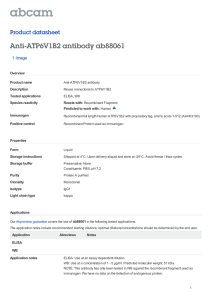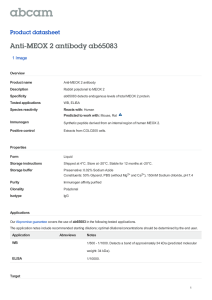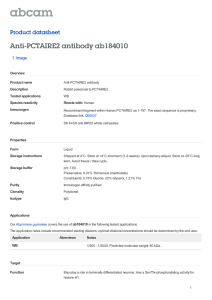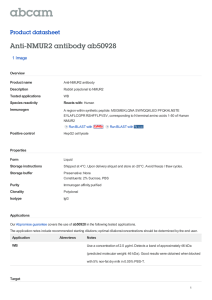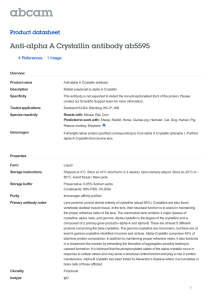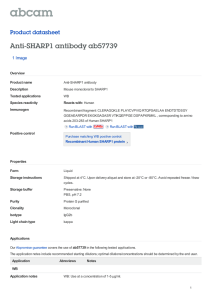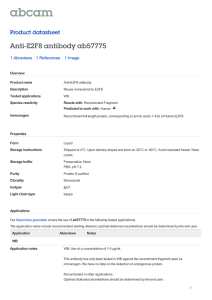Anti-beta B1 Crystallin antibody ab54655 Product datasheet 1 Abreviews 2 Images
advertisement
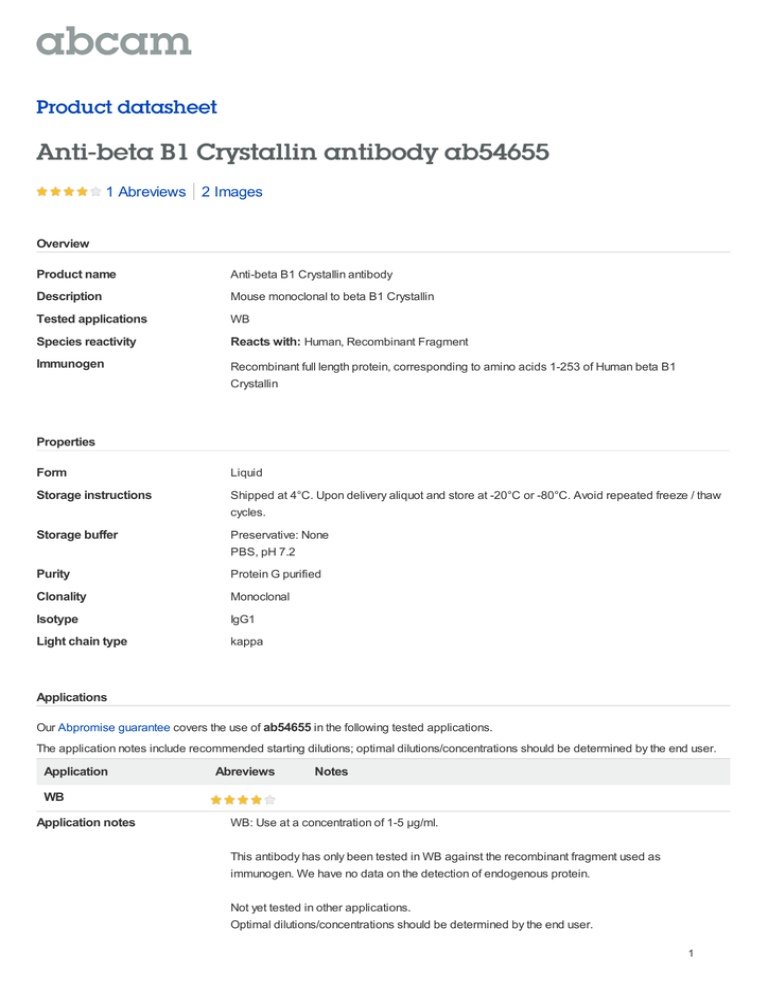
Product datasheet Anti-beta B1 Crystallin antibody ab54655 1 Abreviews 2 Images Overview Product name Anti-beta B1 Crystallin antibody Description Mouse monoclonal to beta B1 Crystallin Tested applications WB Species reactivity Reacts with: Human, Recombinant Fragment Immunogen Recombinant full length protein, corresponding to amino acids 1-253 of Human beta B1 Crystallin Properties Form Liquid Storage instructions Shipped at 4°C. Upon delivery aliquot and store at -20°C or -80°C. Avoid repeated freeze / thaw cycles. Storage buffer Preservative: None PBS, pH 7.2 Purity Protein G purified Clonality Monoclonal Isotype IgG1 Light chain type kappa Applications Our Abpromise guarantee covers the use of ab54655 in the following tested applications. The application notes include recommended starting dilutions; optimal dilutions/concentrations should be determined by the end user. Application Abreviews Notes WB Application notes WB: Use at a concentration of 1-5 µg/ml. This antibody has only been tested in WB against the recombinant fragment used as immunogen. We have no data on the detection of endogenous protein. Not yet tested in other applications. Optimal dilutions/concentrations should be determined by the end user. 1 Target Function Crystallins are the dominant structural components of the vertebrate eye lens. Involvement in disease Defects in CRYBB1 are the cause of cataract congenital nuclear autosomal recessive type 3 (CATCN3) [MIM:611544]. A congenital cataract affecting the central nucleus of the eye. Nuclear cataracts are often not highly visually significant. The density of the opacities varies greatly from fine dots to a dense, white and chalk-like, central cataract. The condition is usually bilateral. Nuclear cataracts are often combined with opacified cortical fibers encircling the nuclear opacity, which are referred to as cortical riders. Defects in CRYBB1 are a cause of cataract-microcornea syndrome (CAMIS) [MIM:116150]. An ocular disorder characterized by the association of congenital cataract and microcornea without any other systemic anomaly or dysmorphism. Clinical findings include a corneal diameter inferior to 10 mm in both meridians in an otherwise normal eye, and an inherited cataract, which is most often bilateral posterior polar with opacification in the lens periphery. The cataract progresses to form a total cataract after visual maturity has been achieved, requiring cataract extraction in the first to third decade of life. Microcornea-cataract syndrome can be associated with other rare ocular manifestations, including myopia, iris coloboma, sclerocornea and Peters anomaly. Transmission is in most cases autosomal dominant, but cases of autosomal recessive transmission have recently been described. Sequence similarities Belongs to the beta/gamma-crystallin family. Contains 4 beta/gamma crystallin 'Greek key' domains. Domain Has a two-domain beta-structure, folded into four very similar Greek key motifs. Post-translational modifications Specific cleavages in the N-terminal arm occur during lens maturation and give rise to truncated forms, leading to impaired oligomerization and protein insolubilization. Anti-beta B1 Crystallin antibody images Western blot against tagged recombinant protein immunogen using ab54655 beta B1 Crystallin antibody at 1ug/ml. Predicted band size of immunogen is 54 kDa. This antibody has only been tested in WB against the recombinant fragment used as immunogen. We have no data on the Western blot - beta B1 Crystallin antibody detection of endogenous protein. (ab54655) 2 All lanes : Anti-beta B1 Crystallin antibody (ab54655) at 1/100 dilution Lane 1 : Zebrafish lens homogenate Lane 2 : Zebrafish lens homogenate Lane 4 : Human Beta B1 crystallin Lane 5 : Human Beta B2 crystallin (Negative Control) Lysates/proteins at 1 µg per lane. Western blot - beta B1 Crystallin antibody Secondary (ab54655) Alkaline phosphatase-conjugated Goat antimouse IgG monoclonal at 1/3000 dilution Observed band size : 45 kDa Additional bands at : 30 kDa,82 kDa. We are unsure as to the identity of these extra bands. This image is courtesy of an Abreview submitted by Dr. Leonel Trujillo Please note: All products are "FOR RESEARCH USE ONLY AND ARE NOT INTENDED FOR DIAGNOSTIC OR THERAPEUTIC USE" Our Abpromise to you: Quality guaranteed and expert technical support Replacement or refund for products not performing as stated on the datasheet Valid for 12 months from date of delivery Response to your inquiry within 24 hours We provide support in Chinese, English, French, German, Japanese and Spanish Extensive multi-media technical resources to help you We investigate all quality concerns to ensure our products perform to the highest standards If the product does not perform as described on this datasheet, we will offer a refund or replacement. For full details of the Abpromise, please visit http://www.abcam.com/abpromise or contact our technical team. Terms and conditions Guarantee only valid for products bought direct from Abcam or one of our authorized distributors 3
